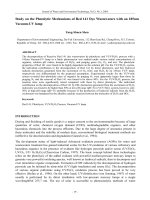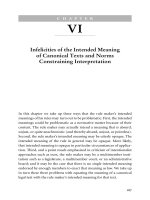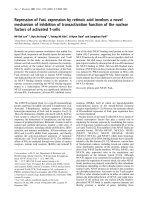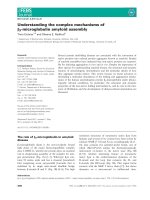The uptake mechanisms of ag and tio2 nanoparticles of nervous system cells
Bạn đang xem bản rút gọn của tài liệu. Xem và tải ngay bản đầy đủ của tài liệu tại đây (1.35 MB, 55 trang )
THAI NGUYEN UNIVERSITY
THAI NGUYEN UNIVERSITY OF AGRICULTURE AND FORESTRY
DUONG THI THU HUYEN
Topic title:
THE UPTAKE MECHANISMS OF AG AND TIO2 NANOPARTICLES
TO NERVOUS-SYSTEM CELLS
BACHELOR THESIS
Study Mode: Full-time
Major: Environmental Science and Management
Faculty: International Training and Development Center
Batch: 2010-2015
Thai Nguyen, January 15th, 2015
THAI NGUYEN UNIVERSITY
THAI NGUYEN UNIVERSITY OF AGRICULTURE AND FORESTRY
DUONG THI THU HUYEN
Topic title:
THE UPTAKE MECHANISMS OF AG AND TIO2 NANOPARTICLES
TO NERVOUS-SYSTEM CELLS
BACHELOR THESIS
Major: Environmental Science and Management
Supervisors: - Assoc.Prof. HUANG, Yuh-Jeen
- Dr. Tran Thi Thu Ha PhD
Thai Nguyen, January 15th, 2015
Thai Nguyen University of Agriculture and Forestry
Degree program
Bachelor of Environmental Science and Management
Student name
Duong Thi Thu Huyen
Student ID
DTN1053110108
Thesis title
The Uptake Mechanisms of Ag and TiO2 Nanoparticles of
Nervous-system cells
Supervisors
Yuh-Jeen Huang Assoc.Prof, Tran Thi Thu Ha PhD
ABSTRACT
Nanosafety is a hot issue in the nanotechnology field nowadays. Nanoparticles may
penetrate the blood-brain-barrier into the central nervous system associated with
neurodegenerative disorders such as Parkinson’s disease, Alzheimer’s disease, and
Huntington’s disease. This report presents the uptake mechanisms of Silver nanoparticles
with average diameters of 3-5 nm and 10-15 nm and Anatase TiO2 nanoparticles (7 nm
(ST-01), 21 nm (ST-21)) nanoparticles, in two nervous-system cells microglia (BV-2) and
astrocytes (ALT). The experiment was performed with Ag and TiO2 nanoconjugates.
Result obtained by alamarBlue viability assay and Fluorescence Microscopy images. The
research was incomplete, but we had understood the basic process of internalization of
nanoparticles. The results demonstrated that the inhibitors have effect to inhibit the uptake
pathways after 2.5h testing via clathrin-mediated and caveolin-mediated endocytosis,
micropinocytosis and phagocytosis. 24.5h experiment of inhibitors uptake pathway
should be taken into future consideration in other researches/studies of the kind with
another method.
Key words
Ag nanoparticle, TiO2 nanoparticle, inhibitors,
nanoconjugates, uptake pathway
Number of pages
54
Date of submission
Jan 15th, 2015
ii
ACKNOWLEDGEMENT
I would like to express the deepest appreciation to teachers in faculty of
International Training and Development as well as teachers in Thai Nguyen
University of Agriculture and Forestry, who have dedicated teaching to me the
valuable knowledge during study time in university and gave me a chance to do
my thesis oversea. It is with immense gratitude that I acknowledge the support
and help of Biomedical Engineering & Environmental Science Department,
National Tsing Hua University for accepting me to working in this wonderful
place.
It gives me great pleasure in acknowledging the support and help of
Associate Professor Huang Yuh-Jeen, who has attitude and the substance of a
great teacher. She did everything to give me the best condition, support all
materials I need to do my thesis during the time I working in her Environmental
Nano Analysis and Energy Laboratory.
I would like to thank to Dr. Tran Thi Thu Ha, who always supported and
cheered up me whole the time I work abroad. She also the one who help me the
most on spending time to check my thesis report.
I consider it is an honor to work with Mr. Alan (Hsiao I-Lun) for 4
months of research. Without his guidance, my research couldn’t be possible.
I cannot find words to express my gratitude to my family and friends, who
always beside me all the time whatever happened, create the pump leading me to
success.
In the process of implementing the project, I know that my thesis report got
many mistakes so this report is inevitable shortcomings. So, I would like to receive the
attention and feedback from teachers and friends to this thesis is more complete.
I sincerely thank you!
Duong Thi Thu Huyen
iii
CONTENTS
LIST OF FIGURES ................................................................................................. 1
LIST OF TABLES ................................................................................................... 3
LIST OF ABBREVIATIONS ................................................................................. 3
PART I. INTRODUCTION .................................................................................... 4
1.1 Rationale of the research .................................................................................................... 4
1.2 Objectives of the research................................................................................................... 4
1.3 Research questions and hypothesis .................................................................................... 5
1.4 Limitations of research ....................................................................................................... 5
1.5 Definitions ............................................................................................................................ 5
PART II. LITERATURE REVIEW....................................................................... 6
2.1. Nanomaterials ..................................................................................................................... 6
2.1.1
TiO2 nanoparticles .................................................................................................... 7
2.1.2
Silver nanoparticles .................................................................................................. 9
2.2 Neuro-cells ..................................................................................................................... 11
2.2.1
Astrocyte (ALT)....................................................................................................... 11
2.2.2
Microglia (BV-2)..................................................................................................... 12
2.3 Endocytosis pathway .................................................................................................... 13
2.4 Inhibitors ....................................................................................................................... 16
2.5 Nanoparticles and neurodegenerative diseases possible relationships .................... 17
PART III. METHODS...........................................................................................20
3.1 Materials ........................................................................................................................ 20
3.2 Neuro-cells culture ........................................................................................................ 23
3.2.1
Astrocyte cell (ALT)................................................................................................ 23
3.2.2
Microglial cell (BV-2)............................................................................................. 23
3.3 Biological analysis methods.......................................................................................... 23
3.3.1
Cell viability assay .................................................................................................. 23
3.3.2
Inhibitors for specific uptake pathways ................................................................. 25
3.3.3
Fluorescence microscope imaging......................................................................... 26
CHAPTER IV. RESULTS ....................................................................................28
4.1 Cell viability assay ........................................................................................................ 28
4.1.1
Astrocyte Cell viability assay .................................................................................. 28
4.1.2
Microglia cells viability assay................................................................................. 30
4.2 Inhibitors uptake pathway................................................................................................ 32
4.2.1
Astrocyte (ALT-after 2.5h and 24.5 hours exposure)............................................ 32
4.2.2
Microglia (BV2- after 2h and 24h exposure) ........................................................ 37
4.2.3
LPS-activated BV2- Dextran conjugate................................................................. 42
4.3 Silver Nanoparticle uptake pathway................................................................................ 43
iv
CHAPTER V. CONCLUSION AND DISCUSSION.......................................... 45
REFERENCES ....................................................................................................... 46
v
LIST OF FIGURES
Figures
Page
Figure 2.1 Crystal structures of the 3 forms of titanium dioxide
8
Figure 2.2 Strategies in the design of nanoparticles for therapeutic
14
applications
Figure 2.3 Possible pathways of neurotoxicity by nanoparticles
19
Figure 3.1 The 96-well plates
25
Figure 3.2 Fluorescence microscope
27
Figure 4.1 ALT cell viability assay result of Chlorpromazine inhibitor
28
Figure 4.2 ALT cell viability assay result of MDC inhibitor
28
Figure 4.3 ALT cell viability assay result of Genistein inhibitor
29
Figure 4.4 ALT cell viability assay result of Filipin inhibitor
29
Figure 4.5 ALT cell viability assay result of Amiloride inhibitor
29
Figure 4.6 ALT cell viability assay result of Phenylarsine oxide inhibitor
29
Figure 4.7 BV-2 cell viability assay result of Chlorpromazine inhibitor
30
Figure 4.8 BV-2 cell viability assay result of MDC inhibitor
30
Figure 4.9 BV-2 cell viability assay result of Genistein inhibitor
31
1
Figure 4.10 BV-2 cell viability assay result of Filipin inhibitor
31
Figure 4.11 BV-2 cell viability assay result of Amiloride inhibitor
31
Figure 4.12 BV-2 cell viability assay result of Phenylarsine oxide inhibitor
31
Figure 4.13 ALT images from Fluorescence microscope after 2.5h and 24.5
33
testing Chlorpromazine and MDC work with Transferrin conjugate
Figure 4.14 ALT images from Fluorescence microscope after 2.5h and 24.5
34
testing Genistein and Filipin work with BODIPY-LacCer conjugate
Figure 4.15 ALT images from Fluorescence microscope after 2.5h and 24.5
36
testing Amiloride and Phenylarsine oxide work with Dextran conjugate
Figure 4.16 BV-2 images from Fluorescence microscope after 2.5h and 24.5
38
testing Chlorpromazine and MDC work with Transferrin conjugate
Figure 4.17 BV-2 images from Fluorescence microscope after 2.5h and 24.5
39
testing Genistein and Filipin work with Transferrin conjugate
Figure 4.18 BV-2 images from Fluorescence microscope after 2.5h and 24.5
41
testing Amiloride and Phenylarsine oxide work with Dextran conjugate
Figure 4.19 LPS-activated BV-2 images from Fluorescence microscope after
42
2.5h testing Amiloride and Phenylarsine oxide work with Dextran conjugate
Figure 4.20 ALT cell images from Fluorescence microscope after 2.5h
43
testing with Ag NPs
2
LIST OF TABLES
Tables
Page
Table 3.1 Sources of Nanomaterials
19
Table 3.2 Materials for biological analysis
19
Table 4.1 Summary of inhibitor work to inhibit uptake pathway
44
LIST OF ABBREVIATIONS
ALT
Astrocyte cell
BBB
Blood-brain-barrier
BV-2
Microglia cell
CNS
Central nervous system
LPS
Lipopolysaccharide
NPs
Nanoparticles
ROS
Reactive oxygen species
3
PART I. INTRODUCTION
1.1 Rationale of the research
In recent years, nanotechnology was born not only create breakthrough leap in
electronics, computer science, biomedical, environmental, but also widely used in the
life. However, when the materials reach nanometer level, due to small particle size,
large surface area, and upgraded reactivity, they may cause harm to human and
organisms. Therefore, nanosafety is a hot issue in the nanotechnology field nowadays.
Scientists have found that nanoparticles may penetrate the blood-brain-barrier
(BBB) into the central nervous system (CNS) or directly translocate onto the CNS
from olfactory nerves. Moreover, neurotoxicity of nanoparticles (NPs) started to catch
attention because the reactive oxygen species (ROS) induced by NPs could be
associated with neurodegenerative disorders such as Parkinson’s disease, Alzheimer’s
disease, and Huntington’s disease.
1.2 Objectives of the research
The specific objective of the project is to understand the processes of
internalization of Ag and TiO2 nanoparticles in two nervous-system cells Microglia
(BV-2) and Astrocyte (ALT). In this study, the nervous-system cells such as Astrocyte
and Microglia is exposed to determine the internalization processes of Ag and TiO 2
NPs with the use of Transwell plate. The cell viability and efficiency of inhibitors in
two kinds of cells were also measured.
4
1.3 Research questions and hypothesis
- Through four main endocytosis pathways, how does NPs enter to nervoussystem cells?
- Which inhibitor will show that it can successfully to block the endotocytosis
pathway to prevent NPs penetrate to cells?
1.4 Limitations of research
Because the thesis training time was too short, this research project is
incomplete.
1.5 Definitions
Nanotoxicology is a new study aimed to determine the toxicity of
nanomaterials and the extent possible threats to the environment and living organisms.
Therefore, nanotoxicology is the study of the potential risks of nanoparticles, and this
is very urgent and very important issue for the environment and the organisms.
Neurotoxicology is the study of the any harmful substances for nervous system
effects of human or animal. Many animal and cell studies have shown that
nanoparticles may produce different biological effects to the central nervous system,
such as leading to cell death, oxidative stress, and so on (Xue et al., 2008). These
results shown that exposure to nanoparticles may directly or indirectly lead to
neurodegenerative diseases such as Parkinson’s disease, Alzheimer’s disease, and
Huntington’s disease. If the average human life continues to increase, the amount of
impacted people will be likely increased to triple in 2050. Therefore, the studies of
nanoparticles are important and needs in neurotoxicology.
5
PART II. LITERATURE REVIEW
2.1. Nanomaterials
Nanomaterials, in principle, are materials of which a single unit is sized (in at
least one dimension) between 1 and 1000 nanometers (10-9 m) but is usually 1-100 nm
(the usual definition of nanoscale) (Buzea et al, 2007). Nanomaterials are the subject
of two science fields: nano-science and nanotechnology, it links these two fields
together. General, it’s divided into two categories of nanomaterials as fullerenes
(carbon-based) and inorganic nanoparticles (silicon-based). Nanomaterials have
interesting properties when its size is comparable to the length of the critical nature
and object of our study. Nanomaterials are capable applications in biology because of
nano size comparable to the size of the cell (10-100 µm), viruses (20-450 nm), protein
(5-50 nm), and gene (2 nm wide and 10-100 nm in length) (Nikiforov and Filinova,
2009). With its small size, plus the "camouflage" like other biological entities and may
penetrate into cells or viruses. There are many applications of nanomaterials in
biological. Nanomaterials used in this case are nanoparticles.
Nanomaterials have a high ratio of surface atoms to total atoms in a single
particle. It’s present that under nano-level, the properties of substances depend mainly
on the surface, and it lead to a completely various physic-chemical properties and
functionalities (Buzea et al, 2007). Therefore, the effect, which is related to the
surface, referred to surface effects is becoming important; make the material
properties of nanometer-sized material differently than the material in bulk form. For
6
macroscopic materials include a lot of atoms, quantum effects are averaged with a lot
of atoms (1 cubic micrometer has about 1012 atoms) and can ignore the random
fluctuations. But nanostructures have less atomic so the quantum properties are being
shown more clearly. For example, a quantum dot can be considered as a nuclear, it has
the same energy level as an atom. Nanomaterials have special properties due to its size
can be compared with the size limitations of other materials. At that time the
resistance of nanoscale materials will adhere to the rules of quantum. Not any material
nanoscale properties are different; it depends on the nature of which it is research.
The nanomaterials, which will be used, will have no surface coating, and have
good dispersion and stability in the cell medium. Silver nanoparticles with average
diameters of 3-5 nm and 10-15 nm will be obtained from Gold NanoTech Inc.,
Taiwan. Anatase TiO2 nanoparticles (7 nm (ST-01), 21 nm (ST-21)) from Ishihara
corporation will be pretreated with alkaline hydrogen peroxide to increase the density
of surface hydroxyl groups on the TiO2 surface.
2.1.1
TiO2 nanoparticles
Titanium dioxide, also known as titanium (IV) oxide or titania, is the naturally
occurring oxide of titanium, chemical formula TiO2. When used as a pigment, it is
called titanium white, Pigment White 6 (PW6), or CI 77891. Generally it is sourced
from ilmenite, rutile and anatase. It has a wide range of applications, from paint to
sunscreen to food colouring. When used as a food colouring, it has E number E171
(Zumdahl, 2009).
7
2.1.1.1
Physico-chemical properties
It is polymorphous and it exists in three types of crystal structures: (a) rutile,
(b) anatase and (c) brookite. Only rutile is used commercially.
Physical structure: Rutile type, sharp titanium type; Crystallization, department
of the four winds of crystal. (See figure 1)
Figure 2.1 Crystal structures of the 3 forms of titanium dioxide (Shanon, 2012)
2.1.1.2 Applications
Given below are some of the chief applications of titanium oxide (Azonano, 2013):
Titanium oxide exhibits good photo catalytic properties, hence is used in antiseptic
and antibacterial compositions
Degrading organic contaminants and germs
As a UV-resistant material
Manufacture of printing ink, self-cleaning ceramics and glass, coating, etc.
Making of cosmetic products such as sunscreen creams, whitening creams,
morning and night creams, skin milks, etc.
Used in the paper industry for improving the opacity of paper.
8
2.1.2 Silver nanoparticles
Silver nanoparticles are nanoparticles of silver, i.e. silver particles of between 1
nm and 100 nm in size. While frequently described as being 'silver' some are composed of
a large percentage of silver oxide due to their large ratio of surface-to-bulk silver atoms.
Exposure to silver nanoparticles has been associated with "inflammatory, oxidative,
genotoxic, and cytotoxic consequences"; the silver particulates primarily accumulate in
the liver (Johnston et al, 2010), but have also been shown to be toxic in other organs
including the brain (Ahamed et al, 2010). Nano-silver applied to tissue-cultured human
cells leads to the formation of free radicals, raising concerns of potential health risks
(Verano-Braga, 2014).
2.1.2.1Physico-Chemical properties
Silver nanoparticles have unique optical, electrical, and thermal properties and
are being incorporated into products that range from photovoltaics to biological and
chemical sensors. Examples include conductive inks, pastes and fillers which utilize silver
nanoparticles for their high electrical conductivity, stability, and low sintering
temperatures. Additional applications include molecular diagnostics and photonic devices,
which take advantage of the novel optical properties of these nanomaterials. An
increasingly common application is the use of silver nanoparticles for antimicrobial
coatings, and many textiles, keyboards, wound dressings, and biomedical devices now
contain silver nanoparticles that continuously release a low level of silver ions to provide
protection against bacteria (Oldenburg, 2014).
9
2.1.2.2 Application
Silver nanoparticles are being used in numerous technologies and incorporated
into a wide array of consumer products that take advantage of their desirable optical,
conductive, and antibacterial properties.
Diagnostic Applications: Silver nanoparticles are used in biosensors and
numerous assays where the silver nanoparticle materials can be used as biological tags for
quantitative detection.
Antibacterial Applications: Silver nanoparticles are incorporated in apparel,
footwear, paints, wound dressings, appliances, cosmetics, and plastics for their
antibacterial properties.
Conductive Applications: Silver nanoparticles are used in conductive inks and
integrated into composites to enhance thermal and electrical conductivity.
Optical Applications: Silver nanoparticles are used to efficiently harvest light
and for enhanced optical spectroscopies including metal-enhanced fluorescence (MEF)
and surface-enhanced Raman scattering (SERS) (Oldenburg, 2014).
2.1.2.3Silver Nanoparticles for Nanotoxicology Research
There is growing interest in understanding the relationship between the
physical and chemical properties of nanomaterials and their potential risk to the
environment and human health. Where the size, shape, and surface of the nanoparticles
are precisely controlled, the availability of panels of nanoparticles allows for the better
correlation of nanoparticle properties to their toxicological effects. Sets of monodisperse,
unaggregated, nanoparticles with precisely defined physical and chemical characteristics
10
provide researchers with materials that can be used to understand how nanoparticles
interact with biological systems and the environment.
Due to the increasing prevalence of silver nanoparticles in consumer products,
there is a large international effort underway to verify silver nanoparticle safety and to
understand the mechanism of action for antimicrobial effects. Colloidal silver has been
consumed for decades for its perceived health benefits (Li et al, 2010), but detailed
studies on its effect on the environment have just begun. Initial studies have demonstrated
that effects on cells and microbes are primarily due to a low level of silver ion release
from the nanoparticle surface (Lubick, 2008). The ion release rate is a function of the
nanoparticle size (smaller particles have a faster release rate), the temperature (higher
temperatures accelerate dissolution), and exposure to oxygen, sulfur, and light. In all
studies to date, silver nanoparticle toxicity is much less than the equivalent mass loading
of silver salts.
2.2
Neuro-cells
2.2.1 Astrocyte (ALT)
Astrocytes, also known collectively as astroglia, are characteristic star-shaped
glial cells in the brain and spinal cord. They are the most abundant cells of the human
brain. They perform many functions, including biochemical support of endothelial cells
that form the blood–brain barrier, provision of nutrients to the nervous tissue,
maintenance of extracellular ion balance, and a role in the repair and scarring process of
the brain and spinal cord following traumatic injuries.
11
Astrocytes are a sub-type of glial cells in the central nervous system. They are
also known as astrocytic glial cells. Star-shaped, their many processes envelope synapses
made by neurons. Astrocytes are classically identified using histological analysis; many
of these cells express the intermediate filament glial fibrillary acidic protein (GFAP).
Several forms of astrocytes exist in the Central Nervous System including fibrous (in
white matter), protoplasmic (in grey matter), and radial. The fibrous glia are usually
located within white matter, have relatively few organelles, and exhibit long unbranched
cellular processes. This type often has "vascular feet" that physically connect the cells to
the outside of capillary walls when they are in close proximity to them. The protoplasmic
glia are the most prevalent and are found in grey matter tissue, possess a larger quantity of
organelles, and exhibit short and highly branched tertiary processes. The radial glia are
disposed in a plane perpendicular to axis of ventricles. One of their processes about the
pia mater, while the other is deeply buried in gray matter. Radial glia are mostly present
during development, playing a role in neuron migration. Mueller cells of retina and
Bergmann glia cells of cerebellar cortex represent an exception, being present still during
adulthood. When in proximity to the pia mater, all three forms of astrocytes send out
processes to form the pia-glial membrane.
2.2.2 Microglia (BV-2)
Microglia is a type of glial cell that are the resident macrophages of the brain and
spinal cord, and thus act as the first and main form of active immune defense in the
central nervous system (CNS).
12
Microglia constitutes 10-15% of all cells found within the brain. Microglia (and
astrocytes) is distributed in large non-overlapping regions throughout the brain and spinal
cord. Microglia is constantly scavenging the CNS for plaques, damaged neurons and
infectious agents. The brain and spinal cord are considered "immune privileged" organs in
that they are separated from the rest of the body by a series of endothelial cells known as
the blood–brain barrier, which prevents most infections from reaching the vulnerable
nervous tissue. In the case where infectious agents are directly introduced to the brain or
cross the blood–brain barrier, microglial cells must react quickly to decrease
inflammation and destroy the infectious agents before they damage the sensitive neural
tissue. Due to the unavailability of antibodies from the rest of the body (few antibodies
are small enough to cross the blood brain barrier), microglia must be able to recognize
foreign bodies, swallow them, and act as antigen-presenting cells activating T-cells. Since
this process must be done quickly to prevent potentially fatal damage, microglia are
extremely sensitive to even small pathological changes in the CNS. They achieve this
sensitivity in part by having unique potassium channels that respond to even small
changes in extracellular potassium.
2.3
Endocytosis pathway
The term endocytosis describes two different cellular uptake mechanisms
(Unfried, 2007): pinocytosis, which involves the uptake of fluids and molecules within
small vesicles and phagocytosis, which is responsible for engulfing large particles (e.g.,
microorganisms and cell debris) (Hillaireau and Couvreur, 2009). Pinocytosis covers
13
macropinocytosis, clathrinmediated endocytosis, caveolin-mediated endocytosis and
clathrin- and caveolin-independent endocytosis (Rothen-Rutishauser et al, 2007).
Figure 2.2 Strategies in the design of nanoparticles for therapeutic applications
(Robby & Joseph, 2010)
14
Phagocytosis and macropinocytosis are both dependent on actin (Kumari,
2010).
Phagocytosis
is
carried
out
by
professional
phagocytes
(i.e.,
monocytes/macrophages, neutrophils and dendritic cells), which in turn form intracellular
phagosomes. Macromolecule and particle uptake is triggered via the interaction of the
responsible receptors on the cell surface and the ligands. Macropinocytosis, which is also
actin-driven, forms protrusions at the outer cell membrane which then again fuse with the
cell membrane by taking up larger fragments or debris.
Clathrin-mediated endocytosis is very well studied and is, like most
pinocytotic pathways, a form of receptor-mediated endocytosis (Schmid, 1997). This
abundant pathway is essential for the uptake of many molecules such as low-density
lipoprotein and transferring (Brodsky et al, 2001). When clathrin-mediated endocytosis is
initiated, the so-called “coated pits” come into play consisting of transmembrane
receptors and cytosolic proteins, such as clathrin and the AP2 adaptor complex (Conner
& Schmid, 2003).
On the other hand, caveolin-mediated endocytosis is responsible for the
homeostasis of cholesterol (Conner & Schmid, 2003). The static structures of caveolae
form flask-shaped invaginations in the cell membrane. Many cell types such as the
capillary endothelium, type I epithelial cells, muscle cells as well as fibroblasts, exhibit
caveolin-mediated endocytosis, which occurs at the site of the lipid rafts (Gehr et al,
2011). These rafts are plasma membrane regions (subdomains), which consist of
glycosphingolipids and high amounts of cholesterol (Pike, 2003). The protein which gives
shape and structure in caveolin-mediated endocytosis is caveolin-1, a dimeric protein
15
which binds cholesterol onto the cellular surface for uptake and intracellular trafficking
(lipid homeostasis) (Rothberg et al, 1992). Also located at the site of lipid rafts is
flotillin-1, an integral membrane protein which forms a hetero-oligomer with flotillin-2
(Kasper, 2013). In addition to the aforementioned uptake mechanisms, clathrin- and
caveolin-independent endocytosis as well as passive diffusion of NPs across the cell
plasma membrane is also addressed (Rothen-Rutishauser et al, 2007).
2.4 Inhibitors
To elaborate on the most important cellular endocytotic uptake mechanism of
NPs, specific pharmacological substances which inhibit specific pathways can be used
(Ivanov, 2008). It is important to highlight that the use of inhibitors must be optimized for
each cell and NP type, since an inhibitor might show a high specificity in one experiment
but cause side effects in another (Rothen-Rutishauser et al, 2007). The use of positive
controls to show that an inhibitor only affects one endocytotic pathway without
interfering with other uptake mechanism(s) is mandatory (Liu et al, 2007). There are
many different inhibitors described, so we will focus only on the most commonly used
drugs to study NPs uptake.
We used specific inhibitors for the two major endocytotic pathways, ie
clathrin-mediated and caveolin-mediated endocytosis. Genistein and filipin were used as
inhibitors
to
block
the
caveolin-mediated
endocytosis.
Chlorpromazine
and
Monodansylcadaverine was used to inhibit the clathrin-mediated endocytosis. Amiloride
hydrochloride was used as inhibitor for micropinocytosis. Phenylarsine oxide was used as
phagocytosis inhibitor to inhibit the LPS-activated BV-2 cells.
16
Chlorpromazine hydrochloride which inhibits clathrin-mediated endocytosis
induces a loss of clathrin and adaptor protein complex 2 from the surface of the cell
(McPherson et al, 2009). It is thus classified as an inhibitor for clathrin-mediated
endocytosis (McMahon & Boucrot, 2011). Monodansylcadaverine (MDC), a competitive
inhibitor, blocks the enzyme transglutaminase 2, which is necessary for receptor
crosslinking in the region of clathrin-coated pits (Ivanov, 2008). Typical sizes of clathrin
coated pits are in the range 60–200 nm diameter (Rejman et al, 2004). Furthermore,
chlorpromazine and MDC are specific in inhibiting the uptake of the serum protein
transferring (Perumal et al, 2008). Consequently, fluorescently labelled transferrin can be
used to investigate clathrin-mediated endocytosis (Rothen-Rutishauser, 2013).
Caveolae and lipid raft internalizations are known to be inhibited by filipin and
genistein through depletion of the cholesterol from the cell membrane by forming
inclusion complexes with cholesterol (Ivanov, 2008). All of these mentioned inhibitors
form aggregates which accumulate cholesterol and separate it from the membrane
structures.
Amiloride hydrochloride and phenylarsine oxide can be used to study actindependent uptake mechanisms, that is, phagocytosis and macropinocytosis. Phenylarsine
oxide was used as phagocytosis inhibitor to inhibit the LPS-activated BV-2 cells.
2.5 Nanoparticles and neurodegenerative diseases possible relationships
Many experiments have shown that engineering nanoparticles could use various
pathways, such as skin, blood, and respiratory, into the brain. Nanoparticles may have two
ways to penetrate the central nervous system, respiratory paths from one transferred to the
17
central nervous system through the blood-brain-barrier (BBB), and the other is
transmitted via the olfactory nerve axons to the brain (Simko & Mattsson, 2010).
Many animal and cell studies have shown that nanoparticles for central nervous
system can produce different biological effects, such as cell death, inflammation,
oxidative stress, neurotransmitter dopamine depletion, etc. Moreover, the hippocampus is
a key part of the memory system; the result showed that nanoparticles exposure may
directly or indirectly lead to neurodegenerative disease (eg Alzheimer’s, Parkinson’s, and
Huntington) generation. Inflammation plays an important role in brain disease. Microglia
and Astrocyte cells will produce inflammation in nervous system. In many pathological
features, when brain gets hurt, microglia cell will be activated, migrate to the periphery of
dead cells, clear cell debris. Activation of microglia is sometimes beneficial to release
some neurotrophic factor.
18
Figure 2.3: Possible pathways of neurotoxicity by nanoparticles
(Win-Shwe & Fujimaki, 2011)
19









